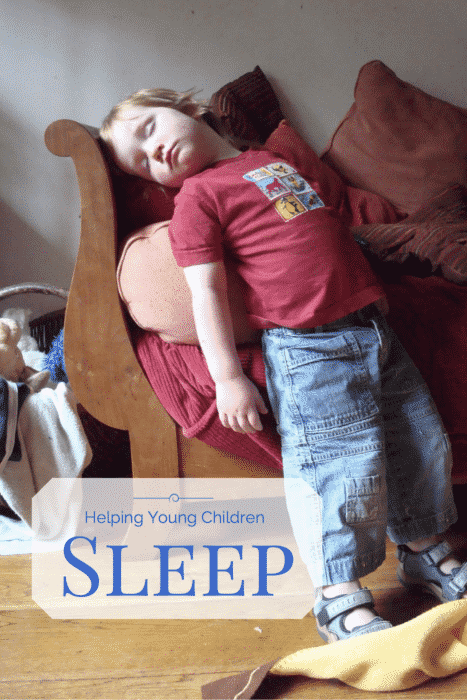Sleep confidence doesn’t come naturally for many children and they struggle at some time or another with going to sleep on their own or sleeping through the night. A toddler or young child left alone without an adult close by to protect them can feel very unsafe. As adults, our sense of where we are safe is much wider, extending far beyond a cozy bed to the whole house or neighborhood. This wider concept of safe surroundings can take years to develop and it is normal for a child to feel they ‘need’ physical contact with an adult before they are confident enough to relax and sleep well.
Most parents do the expedient thing to get their little one to sleep—they will nurse them or give them a bottle, lay down with them, or snuggle them into the parent’s bed and hope for another few hours of rest. For some lucky parents, there’s a slow progression toward less waking in the night that ends in all-night sleeping. But other parents put in months of patient accommodation, followed by frustration and mounting stress because neither they nor their child can sleep through the night.
Children need us to respond to them when they wake in the night
We parents want to help our children learn to sleep through the night, but are often uncomfortable with recommended methods that require letting the child cry, frightened and alone, in their own bed or room, without response from us. Many parents can’t bear to do this. It doesn’t sit well with our instinct to help and to be trustworthy when our child needs reassurance. That instinct is good.
Parents do need to respond when a child cries. Children need to know that we will be there for them, especially when their whole system is telling them that something is amiss.
Helping young children sleep with the “I’ll listen until you can fall asleep” approach
There is an effective and supportive way to handle a child’s sleep troubles. This approach allows your child to dissolve the tension that wakes them, and allows you to help them recover and sleep peacefully. It's not an easy approach, but it's loving, respectful, and it works.
The principles on which this approach is based are these:
- When children can't sleep through the night (and there are no health or developmental issues such as a fever or a growth spurt), the cause is most likely some kind of emotional tension or stress that bubbles up in the child's mind during sleep.
- Children’s emotional stress is relieved when an adult can stay close and listen to how the child feels. The crying, struggling, perspiring, and trembling that children do actually helps heals their fear and grief, if a parent can be reassuring and attentive. Expressing intense emotion is the child's own best way of getting free of feelings they harbor. Those feelings have sprung from some difficult, unwell, or restless time, either recent or long past.
- Children’s systems are built to express feelings of upset immediately and vigorously. But our training as parents is to stop them from sharing their feelings! We are taught to give them pacifiers, food, rocking, patting, scolding, and later, time outs and spanking, if the crying or screaming goes on for more than a minute. We are taught to work against our child’s own healthy instinct to get rid of bad feelings immediately.
So our children store these upsets, and try many times a day to work them out, usually by testing limits or having meltdowns over small issues. If they can’t offload them during the day, the feelings can bother them in the night.
This is why nursing, rocking, or patting a child who wakes doesn’t keep him from waking again. In fact, as a child’s storehouse of feelings gets fuller they wake more often, trying to find an outlet. Parents try to solve the problem by offering food or allowing the child to sleep with them as a way to pat the feelings down again. But over time, the pent-up tension inside the child can become trouble for everyone.
Healthy families in many cultures allow children to sleep with parents, and if that works for your family, great. But, if your sleep schedule doesn't line up well with your child's, or if the good effects of sleeping close together are negated because no one sleeps well in that arrangement at your house, you do have other options.
Help your child release the feelings that wake them up

This is easier to do during the day than at nighttime, so a good strategy to try first is to listen to your child’s feelings of upset when they arise during the day. Simply get close, say one or two loving things to them, offer warm eye contact and gentle touch, and let they cry or even tantrum until they feel better.
Children pick lots of little pretexts to help them release pent-up feelings. They will cry about a shirt being put on over their heads, about having a shampoo, about you moving six steps away to do the dishes, or about how their mittens don't fit into their coat sleeves quite right. When a big cry begins, stay close, be interested in all the feelings they have, and don't try to fix the little thing that upset them. Just listen to how they feel about it for as long as you can.
When children feel you listening, they often cry harder. Your loving attention is reassuring enough to let them tackle big feelings of fear and grief. Trust that your child knows what they are doing as they cry with your support. You’ll see good results afterward. A passionate cry in your arms will help your child relax, trust you, and see the world as a safer place. All they need is for you to be close and confident that all is well.
If daytime listening isn’t enough to ease night waking, listen at night
You may want to take a week to set things up so you can get an extra nap during the day, or buy earplugs for the rest of the family.
- When your child wakes the first time, go to them and turn on a low light so they can see you and see that they are safe. Make close physical and eye contact.
- Tell them it’s OK to go back to sleep, and it’s not time to nurse or have a bottle or come into bed with you right now. Tell him that all is well. “I’m right here. You’re safe as safe can be.” “You have everything you need, darling. I’m not going to go away.” Offer warm touch, but don’t bring them into your arms immediately. Keep gently moving them toward lying down again.
- Listen to their feelings. If they tremble, writhe away from you, arch their back, shut their eyes tight, and make lots of motion, things are going well. Those signs indicate that they are releasing the fears that won’t let them or you rest. It might look or sound awful, but they are using a powerful healing process—one they were born to use—and they will be able to sleep well afterward. As you listen, your child absorbs your love.
- If they are crying vigorously, you may be able to bring them into your arms and hold them while they cry. After a few moments of crying, many children have grabbed onto the feelings they need to release, and being held by you doesn’t distract them from crying hard. Other children stop crying the moment they are held close. If your child stops crying in your arms, remind them that it’s time to go back to sleep, and move slowly toward putting them back to bed.
- Remember as you listen that your child has everything they need. They have you watching over them. They have your warmth and they are safe right next to you. They can't tell all is well because of feelings inside, not because of something lacking in the present moment.
- Allow them to cry until, either, they are happy to be put back to bed, or until they fall asleep in your arms. This can take anywhere from a few minutes to an hour or more, depending on how many feelings have been pressing on them.
- Observe their behavior the next day. Generally, children who get a good chunk of crying done are able to make visible gains in confidence, closeness, and relaxation. Sometimes you'll see gains in their physical skill and courage. Sometimes, after a parent has listened at length for the first time, the child’s instincts say, “At last! They're listening!” and they find ways to set up another big cry the next morning. If you can listen again, their load will be lightened once more. It might take several listening “sessions” before a child is able to sleep better, but you will see some positive changes in their functioning that will tell you they are making progress.
Listening to a child’s feelings works over time
This process depends on factors you can't know ahead of time. Children who've had stressful times before birth, during birth, or early in their infancy sometimes ask for help with their fears in the middle of the night for months. Other children need to be listened to only occasionally, especially during and after illnesses, or when there's increased stress in their lives. In any case, your child will become more confident, will feel closer to you, and relate better to others if you can listen to their feelings in the night at least some of the time.
You may feel the need to cry, too, while your child is crying about their feelings. In fact, our children's crying often brings up the strongest feelings we have! This is because most of us seldom got a chance to cry away the hurt feelings we gathered as children. When our children cry, something inside us says, “Hey! I have big feelings too!” So finding another adult to talk with who won’t be upset if your feelings spill over is an important part of preparing to help your child. You'll be a better listener for having been listened to.
Working on sleep brings a great day at school

Here’s one parent’s experience of gathering the courage to listen to a child’s fears at bedtime:
The little girl had just turned three. She had changed child care situations recently, and was spending her days doing OK, but wasn’t yet entirely comfortable in her new center, though it was well-run and had attentive staff. She “waited,” in a sense, marking time until her parents came to pick her up. She also was having lots of trouble sleeping in her own bed at night.
Her parents decided to try to help her with her fears of being in her own room. They played with her, cuddled, and made a special effort to connect with her before bedtime, to insure that she had a full sense that they were on her side. Then, they read her the customary story, and said, “OK we're going to go now. Good night!” She raised her usual complaints and began to feel fearful. They said, “We'll just be in the living room. You are safe.” She began to protest, but her Mom, whose attention she was most attached to at bedtime, moved toward the door. Her Dad stayed at her bedside.
She began to cry for her Mommy. Her Mom stopped and turned to face her, reassuring her that she was safe, and that Mommy wasn't going to go far. Her Dad held her in his arms and she cried for a long time. When she would stop crying, her Mom would say, “OK, I'm going to go a little farther now,” and take another step toward the door. She would cry some more. Her mother inched out the door over the next half hour, listening to her daughter the whole time, until she was out of sight. She continued to cry. Her Mom talked to her, but stayed where she couldn't be seen.
Then, her Dad began to get up. This brought more crying. It was a long “session,” which ended with her crying until she fell asleep, with her Daddy part way out of the room. The parents had listened to her feelings, and had stayed close, but not so close as to stop her from fully feeling the gradual separation.
The crying had felt intense and her parents were very worried about the effect it might have on her. They went to sleep almost sure they had done the wrong thing, and had put her through a hurtful and traumatic time. They worried about how to help her the next day.
But their daughter woke up bright and eager to go to day care. She seemed fine, and her parents were relieved. When her Dad picked her up from day care that afternoon, the teacher made a point of seeking him out, and said, “You know, your daughter had an amazing day today. She was outgoing, she set up games that included several of the children, and they all laughed a lot and had a great time. We've never seen her so lively and self-assured!”
It was then clear how useful listening to her feelings had been. It had relieved fears about sleep, as well as feelings that had kept her on the outskirts of play every day. The little girl had a few shorter cries about sleep in the next week or so, and then she could tell she was safe in her own bed.
Another tool to help tackle sleep problems is rough and tumble play. This kind of play before bed can be an ideal way to let off steam, help children sleep, and build connection.
Get our parenting tips newsletter for help and advice for all your parenting struggles.



